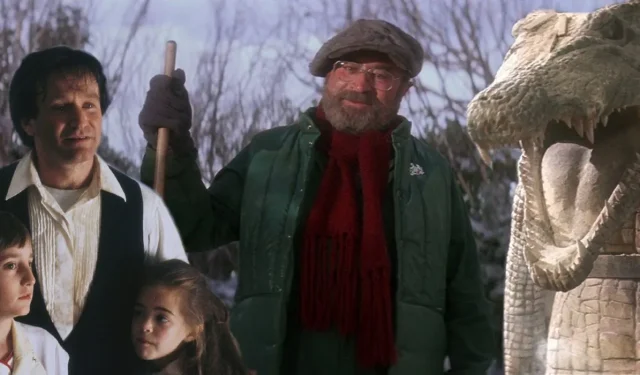
Understanding the Ending of the 1991 Film Hook
The 1991 film Hook, directed by Steven Spielberg, remains a beloved classic among many millennials despite critiques from its own helmsman. The story centers around an adult Peter Pan, portrayed by Robin Williams, who embarks on a journey of self-discovery after Captain Hook (Dustin Hoffman) abducts his children, Jack and Maggie (Charlie Korsmo and Amber Scott), taking them to Neverland. The film boasts a captivating cast, stunning set designs, and an enchanting score by John Williams that evokes nostalgia, igniting strong emotional connections for viewers.
Debate Surrounding the Finale
Although Hook is celebrated for its charm, discussions about the film’s ending continue to thrive on platforms like Reddit. The climax features a grand battle between Peter Pan and Captain Hook, concluding with Peter’s victorious return to England with his children. However, this conclusion raises numerous questions regarding significant themes, such as the implications of Hook’s death and the evolving dynamics of Peter’s family. Minor yet intriguing points, such as Smee’s appearance in England and the fate of Toodles’ marbles, also invite analysis.
Hook’s Death by the Crocodile Clock
The demise of Captain Hook serves as a poignant reflection of his dread regarding time. After Peter shows mercy, Hook attempts to reclaim control with a lethal strike, only to have his hook redirected into the crocodile clock behind him. This causes a series of rapid movements that culminate in Hook’s ironic end. The crocodile’s unyielding jaw opens, and in a perplexing twist, it remains agape while Hook disappears, leading viewers to interpret that he was indeed consumed. It’s emblematic that his prized clock, once a symbol of his identity, ultimately leads to his downfall.
Peter’s Commitment to Family
Throughout the narrative, Peter’s journey involves reconnecting with his youthful spirit to strengthen his bond with his children. As he embraces his persona as Peter Pan, he transitions from a tedious lawyer to a playful father, embodying the whimsical nature of childhood. This revelation becomes evident as he learns to enjoy life alongside Jack and Maggie rather than merely exert authority. A significant turning point occurs at the film’s close when he embraces his children with a newfound passion, signaling a transformation from neglect to attentive parenthood.
Tootles and His Marbles
Restoring Tootles’ Happy Thoughts
One of the film’s most touching moments is when Peter returns Tootles’ marbles, which symbolize his lost childhood joy. Initially dismissed by Peter as senile, Tootles is revealed to have maintained an innocent heart, awakening pivotal memories tied to happiness. The restoration of the marbles not only rejuvenates Tootles but showcases that the essence of being a child is timeless and can be reclaimed at any age, reinforcing that joy is a state of mind.
Smee’s Appearance in London
Theories Surrounding Smee’s Role
Smee’s unexpected presence in London at the film’s conclusion has sparked myriad theories about its implications. Some suggest that Spielberg intended to sow doubt in the audience’s mind, akin to the dreamlike conclusion of The Wizard of Oz. However, Tinkerbell’s lines about the space between sleep and wakefulness seem to solidify that Neverland was real, complicating the dream theory. Alternatively, Smee may have followed Peter back to London, covertly blending into the environment to keep a watchful eye on Peter’s family.
Analyzing the True Message of Hook
Live in the Moment
The conclusion of Hook resonates with Peter’s iconic quote, “To live would be an awfully big adventure.”The film ultimately encourages audiences to cherish their present moments, as time is relentless and precious. As viewers witness the transformations in Peter’s life, they are compelled to consider their priorities, embracing the magic of life before it slips away.
Reception of Hook‘s Ending
Mixed Reviews Over Time
Hook garnered a wide array of reviews, particularly regarding its ending, which elicited mixed reactions from various demographics. While children were enchanted by the reimagining of Neverland, adults scrutinized the concluding scenes, particularly Smee’s enigmatic appearance in London.
Then comes the ending of the movie. Or the endings. One after another. Farewells.
Poignancy. Lessons to be learned. Speeches to be made. Lost marbles to be rediscovered. Tears to be shed. The conclusion of “Hook”would be embarrassingly excessive even for a movie in which something of substance had gone before.
More than three decades later, the nostalgic lens through which many view the film colors their perception, offering an appreciation that contrasts sharply with the view of adults who experienced it in their youth. Spielberg himself expressed that although he had reservations about much of the film, he felt a sense of accomplishment regarding the opening act and the epilogue.
I felt like a fish out of water making Hook… I didn’t have confidence in the script. I had confidence in the first act and I had confidence in the epilogue. I didn’t have confidence in the body of it.
In the end, while some may critique the film’s confusing moments, many fans still find joy in Redux from their childhood memories, celebrating Hook as a compelling reminder of the transient nature of life and the necessity to find and embrace magic in every moment.




Leave a Reply